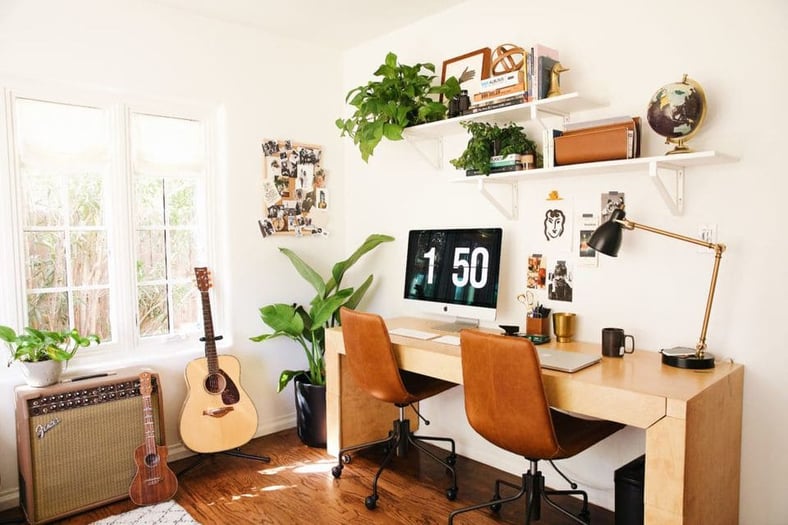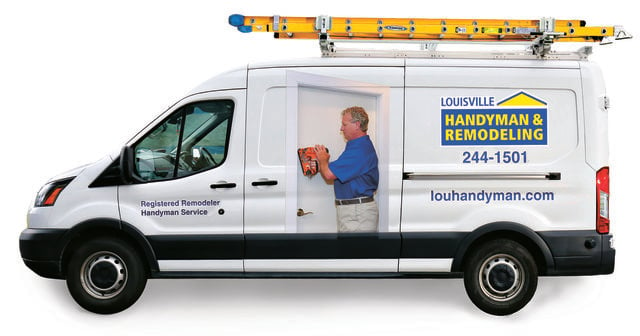How To Separate Your Work Space from the Rest of Your Home
- 21 Jan, 2021
- •
- 0 Comments
Are you working from your Louisville, KY home these days but are finding it hard to separate your workspace from the rest of your house? Or perhaps you have had a work at home career for some time now. However, you would like to define your work living space so you can get better at keeping your work and personal life separate? Either way, creating a home office is the best way to achieve this goal.
When working from home, there are plenty of hurdles to overcome. However, once you overcome those hurdles, you will find your work from home office space and work-life balance are clicking along in tandem like a well-oiled machine.
Well, that all sounds great, but how do I get to that point? That’s what we are here to help you with. So, let’s get started.

Developing the Foundation for Your Work from Home Offices
Before you begin, you will need to think through what you want to achieve. You can do that by asking yourself some questions. The following questions will help you narrow down what type of home workspace will best suit your needs. Then you can follow through by setting up a home office that matches your plan.
How Do I Separate My Home Office from the Living Room?
If you are thinking about using part of the living room for your home workspace, consider how that room is used throughout the day. This will help determine if the living room is the best possible place for your home office. Is the living room quiet? Does it have the space you need for a home office? Then, based on those answers, you might need to add some walls or have a corner of the living room built out to accommodate a home office.
How Do You Separate Work from Home and Home from Work for Home?
This sounds redundant but it’s not. Once you have a separate home workspace set up, you will need to learn how to separate your professional work from the work you need to get done at home. For example, schedule a set time or times each day that you will spend at your desk to work on your professional work and what times you will do the personal things that need to get done around your home.
This will help when thinking about setting up a home office. You don’t want to put your work living space next to the kitchen or other room that might distract you or tempt you into abandoning your work or a room that will keep distracting you while you are trying to concentrate.
How Can I get Work Space at Home?
To find the best possible workspace at home, it is best to think outside of the box. Look at every corner of every room in your home. Then look at the wide-open spaces as well. While looking at each potential home office space, picture yourself working in that spot. Then assign the pros and cons to each space. This will help you narrow down and ultimately decide on the best possible spot for your work from home office space.
How Do I Set Up a Home Office in My Bedroom?
If you have decided to set up a home office in your bedroom, you should consider how it will affect the other ways you use your bedroom. For example, what distractions are there, will the notifications from you PC or other equipment noise keep you from sleeping, etc.
How Do You Make a Home Office in a Small Space?
If you don’t have much space in your home, you will need to get creative. You could consider adding some divider walls and a fold-down desktop. Or, you could have some wall niche spots cut out of select areas on the sheetrock, etc.
How Do You Make Your Own Space?
If you don’t have any available space for a home office, you will have to make a space. Perhaps a portable workstation that can be moved around as needed. You could build a home office space on wheels. That way you could move it to the center of the room when you need to work then roll it back to the corner of the room when you are not using it.
Now that you’ve answered the above questions, you can then decide if you want to make your work living space in your living room, bedroom, or in another small space in your home. Or, if you need to make your own space out of another area.
Setting Up a Home Office
Now that you will be living in an office space so to speak, you will first need to figure out how to separate work from home by learning how to set up an office. And the first step to setting up a home office space is creating physical and mental boundaries.
1. Creating a Plan for Physical and Mental Boundaries
The physical boundaries could include creating walls, cubicles, remodeling an unused closet or guest room, adding a home addition, converting a garage, etc. The physical boundaries will depend on the space you have available and what your specific needs are.
Setting mental boundaries could include talking with your family and setting strict, non-flexible rules for when you are working. That means defining when someone can and can’t disturb you and what the consequences will be if those rules are broken.
2. Physical Boundary Options
You might consider one or more of the following for your physical boundary options.
-
Adding Glass Doors and/or Fixed Glass Windows
Adding glass doors adds a physical boundary that kids would have to step through, which also serves as a mental boundary for your family as well. The beauty of glass doors is that you can still see through them to keep an eye on what’s going on in your house. Fixed glass windows will also give your home workspace a boundary that still allows you to keep an eye on your kids. And, they will also provide you with a place you can keep closed so you won’t hear any background noise such as the TV, kids crying, dogs barking, etc.
-
Home Additions
If you are going to be working at home, you might want to consider a home addition. This could include converting your current space or repurposing an existing space such as your garage or basement. Adding a home addition by converting space you already have into a home office is the absolute best way for keeping personal and professional lives separate.
-
Build Wall(s)
Building a wall or walls is a great way to create a separate space. You will be amazed at what you can create by simply adding a wall or two.
You could build a wall to…separate your working living space from the rest of the house.
You could build a wall to…create a home learning center for your kids. This would give you and your kids each your own designated workspaces perfectly outfitted for each person’s needs.
You could build a wall to…separate a corner or two from any given room.
You could build a wall to…create a physical no-cross boundary to keep others away from your sensitive work tools and content.
Walls can be added almost anywhere and serve endless purposes. Therefore, walls are perfect for creating the perfect work-life balance.
3. Install a Doggie Door
Are you tired of having your dog interrupt your calls to let you know they need outside. One of the best ways to eliminate interruptions is to have a doggie door installed on your home. Having a doggie door installed means you won’t have to stop what you are doing throughout the day to let your dog outside.
What's Next?
Would you like more information about setting up a home office so you can work on keeping your personal and professional lives separate? If so, please Contact Louisville Handyman & Remodeling today. We are a local family-owned and operated business. And, we are committed to providing you with a highly-experienced team of craftsmen to ensure you are completely satisfied with your finished product while exceeding all your expectations.








